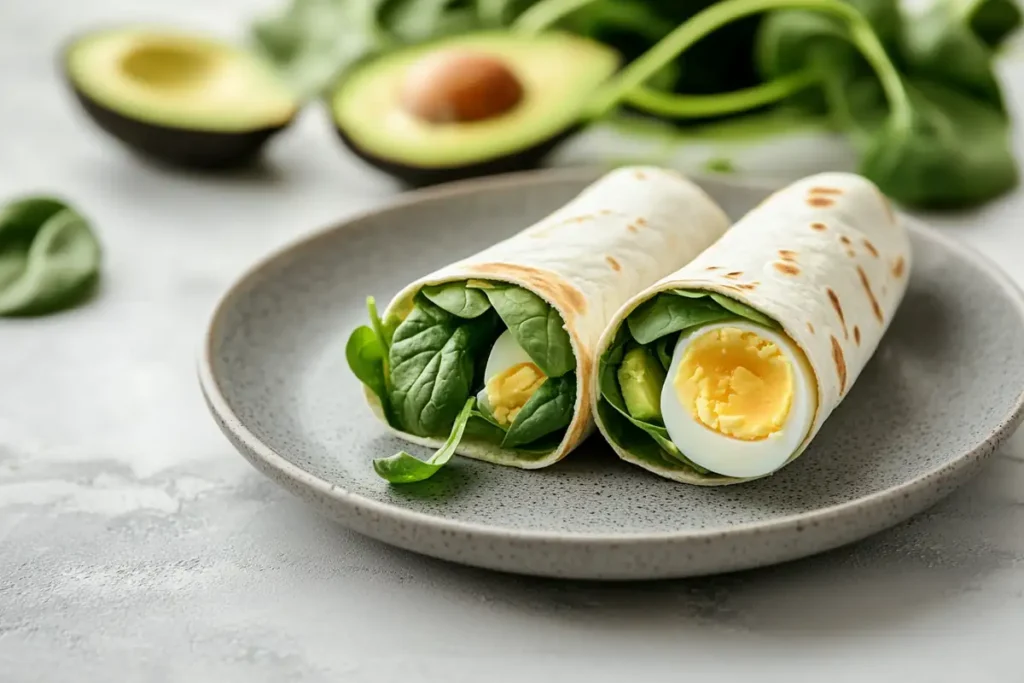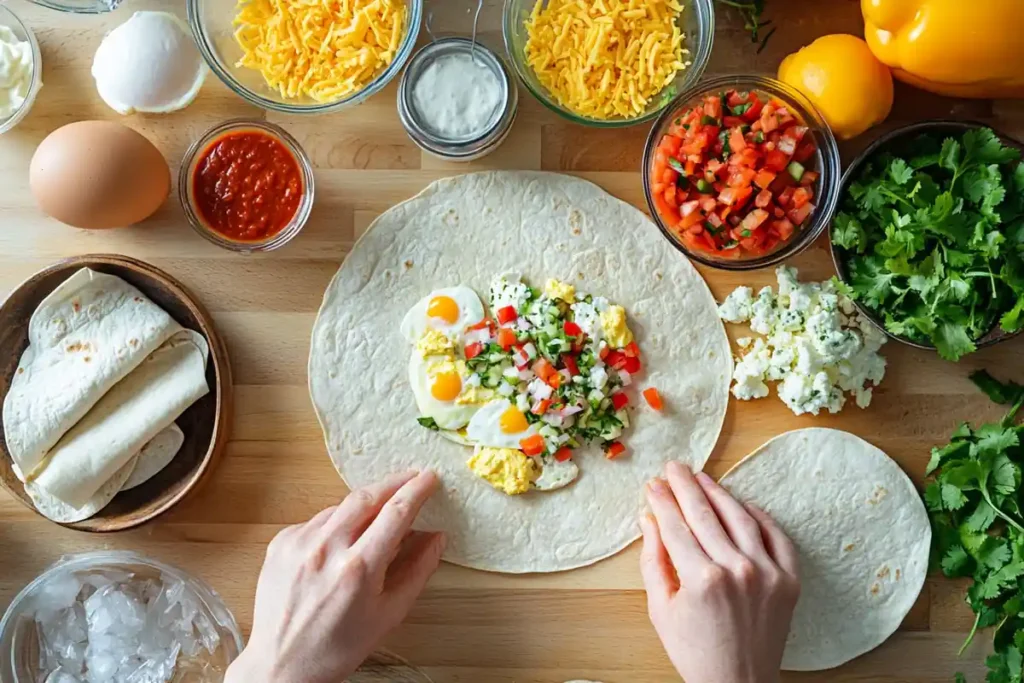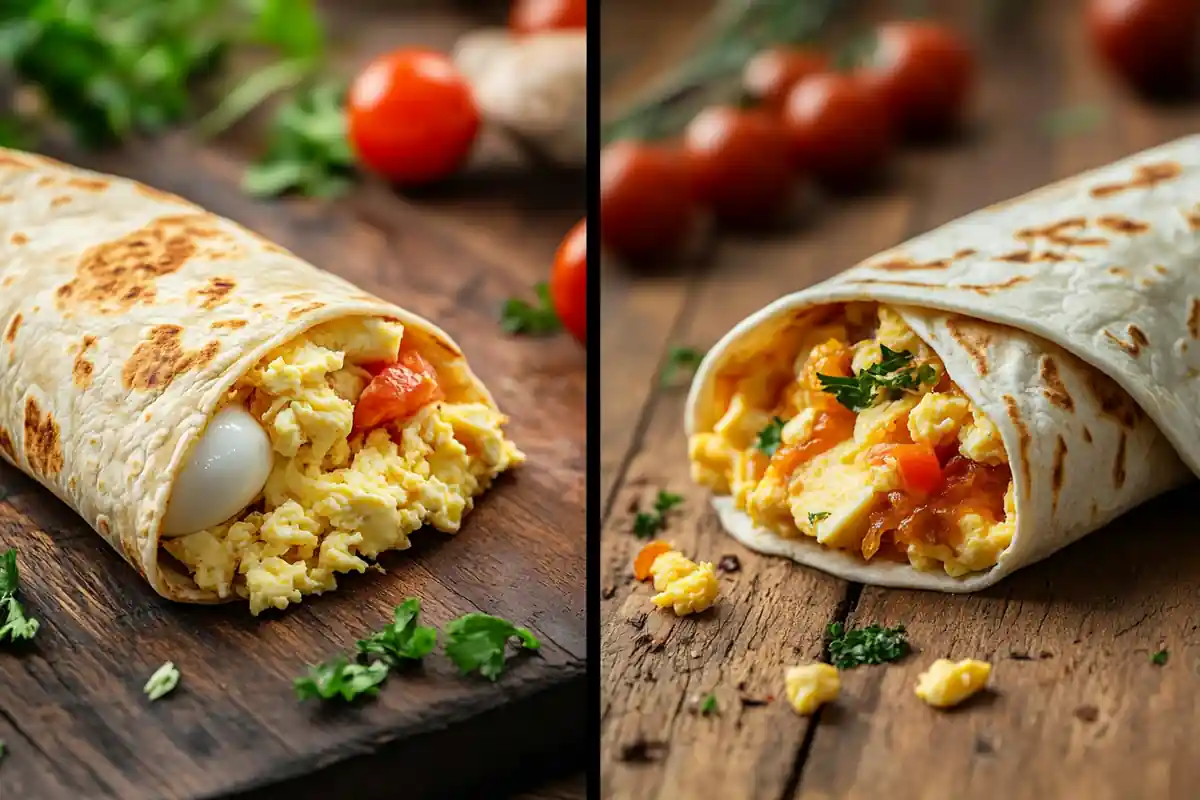Differences between a breakfast burrito and a wrap”—this question often sparks debate among breakfast lovers. While both are delicious, portable morning meals, they have distinct differences in ingredients, preparation, and even cultural origins. Let’s break down what sets them apart and help you decide which one suits your taste buds best! From their origins to their structure and flavors, this article will dive deep into the delicious distinctions between a breakfast burrito and a breakfast wrap.
Introduction
Why This Topic Matters
In today’s busy world, breakfast often needs to be quick, portable, and fulfilling. Breakfast burritos and breakfast wraps tick all these boxes, but they’re not the same. For foodies, health enthusiasts, and curious eaters, understanding their differences can help you decide which fits your taste buds or lifestyle better. Whether you’re cooking at home or ordering on the go, this knowledge makes all the difference.
Overview of Breakfast Trends in the U.S.
Over the years, breakfast habits in the U.S. have shifted dramatically. Once dominated by cereals and toast, modern breakfasts now feature versatile creations like burritos and wraps. The rise of global flavors and customizable fast-food menus has fueled their popularity. But are these two morning marvels interchangeable?
Understanding Breakfast Burritos
What Is a Breakfast Burrito?

The breakfast burrito is a culinary icon that seamlessly blends tradition and innovation. A classic breakfast burrito features a hearty filling wrapped in a flour tortilla, designed to satisfy even the hungriest appetites. But it’s more than just a portable meal; it’s a flavorful homage to Mexican-American cuisine.
Historical Origins of Breakfast Burritos
While burritos themselves trace back to Mexican cuisine, the breakfast burrito is a distinctly American creation. It gained popularity in the southwestern United States, particularly in New Mexico, where local flavors like green chiles became a staple addition. Over time, its appeal spread nationwide, turning the breakfast burrito into a morning favorite.
Typical Ingredients in a Breakfast Burrito
A breakfast burrito is often packed with hearty ingredients that make it a complete meal. These typically include:
- Scrambled eggs
- Shredded or melted cheese
- Potatoes or hash browns
- Proteins such as sausage, ham, or tofu
- Veggies like peppers, onions, and spinach
Add-ons like salsa, guacamole, or sour cream provide extra flavor, making each bite a perfect blend of textures and tastes.
Cultural Significance and Popularity
The breakfast burrito is more than just food; it’s a symbol of convenience and indulgence. Its roots in Mexican-American culture add authenticity, while its adaptability to different flavors keeps it relevant. Today, breakfast burritos are not just a home-cooked option—they’re a fast-food staple, especially in regions like California and Texas.
Understanding Breakfast Wraps
What Is a Breakfast Wrap?

The breakfast wrap is a modern twist on the concept of portable breakfasts. Often viewed as a lighter or more health-conscious alternative to the breakfast burrito, a wrap features ingredients rolled in a thinner, more versatile tortilla or flatbread. It’s a favorite among busy professionals and health-conscious individuals looking for a quick, nutritious start to the day.
Evolution of Breakfast Wraps
Unlike the burrito, which has deep cultural roots, the breakfast wrap is a relatively recent invention. Emerging from the broader trend of handheld meals, breakfast wraps gained traction in the 1990s as part of the health-food movement. Cafes and fast-food chains soon embraced the concept, offering wraps as a convenient and customizable breakfast option.
Typical Ingredients in a Breakfast Wrap
A breakfast wrap often features a simpler and lighter ingredient list compared to its burrito counterpart, with a focus on balance and variety:
- Scrambled eggs or egg whites
- Fresh veggies like spinach, tomatoes, and avocados
- Lean proteins such as turkey, chicken, or plant-based options
- Optional spreads like hummus or low-fat cream cheese
The wrap’s adaptability makes it ideal for adding superfoods, such as kale or quinoa, for an extra nutritional boost.
Why Breakfast Wraps Have Gained Popularity
Breakfast wraps cater to those looking for a healthier or more portion-controlled option. Their smaller size, compared to breakfast burritos, appeals to lighter eaters. Moreover, the wrap’s thin tortilla or flatbread allows the ingredients’ flavors to shine without overwhelming them. Fast-food chains and cafes have also embraced breakfast wraps, promoting them as a nutritious alternative.
Key Differences Between Breakfast Burritos and Breakfast Wraps
Structural Differences
Size and Fold Style
One of the most noticeable distinctions is the size. Breakfast burritos are typically larger, made with flour tortillas big enough to accommodate multiple ingredients folded tightly to hold everything together. In contrast, breakfast wraps are smaller, often using thinner tortillas or flatbreads, rolled up neatly without the need for intricate folding techniques.
Ingredients and Fillings
Breakfast burritos are usually packed to the brim with hearty ingredients like eggs, potatoes, beans, and cheese, often layered for a robust bite. Breakfast wraps, on the other hand, focus on balance and simplicity, with leaner proteins and more fresh vegetables. This difference makes wraps feel lighter and more health-conscious.
Regional and Cultural Influences
Mexican Cuisine vs. Fusion Cuisine
Breakfast burritos reflect their Mexican-American heritage, featuring ingredients like tortillas, salsa, and spicy peppers. They carry the essence of southwestern flavors, making them a cultural staple in areas like Texas and New Mexico. Breakfast wraps, however, lean more toward fusion cuisine, drawing inspiration from Mediterranean, American, or even Asian flavors. This versatility allows wraps to be tailored for global palates.
Nutritional Comparison
Caloric Content
When it comes to calorie count, breakfast burritos tend to be more indulgent due to their larger size and ingredients like cheese, potatoes, and hearty proteins. Breakfast wraps, however, often come in under the calorie radar, using lighter ingredients and smaller portions.
Healthier Options
Breakfast wraps are the go-to choice for those prioritizing health, as they often feature whole-grain tortillas, low-fat proteins, and fresh greens. While burritos can also be made healthier, they are traditionally seen as a more indulgent option.
Texture and Flavor Profiles
Contrasting Tastes
The flavor profile of a breakfast burrito leans toward richness, thanks to savory fillings like cheese and cooked vegetables, combined with spicy or smoky elements like salsa or chiles. Breakfast wraps offer a fresher, cleaner taste, with ingredients like raw vegetables and lighter dressings taking center stage.
Varied Textures
Burritos often have a soft and hearty texture, with fillings melting together into a cohesive bite. Wraps, however, prioritize crunch and variety, often incorporating fresh, crisp vegetables or toasted flatbreads for a dynamic texture.
Breakfast Burritos and Wraps in Modern Cuisine
Customization and Fusion Trends
International Variants
Both breakfast burritos and breakfast wraps have been adapted across the globe to suit local tastes. In Japan, breakfast wraps may include teriyaki chicken or pickled vegetables, while in India, breakfast burritos might feature spiced potatoes and paneer. These international twists demonstrate the versatility and appeal of these breakfast staples worldwide.
Popular Additions
Modern twists on burritos and wraps include trendy ingredients like avocado, smoked salmon, and plant-based proteins. Fusion flavors, such as Korean-inspired breakfast burritos with kimchi or Mediterranean wraps with hummus and falafel, are becoming increasingly popular at cafes and restaurants.
Vegetarian, Vegan, and Gluten-Free Options
In today’s health-conscious world, breakfast burritos and wraps have evolved to meet various dietary needs. Many establishments now offer:
- Vegetarian options featuring roasted vegetables, eggs, and cheese.
- Vegan options with tofu, plant-based cheese, and a selection of veggies.
- Gluten-free wraps made with alternatives like lettuce leaves, rice paper, or gluten-free tortillas.
These adaptations ensure that everyone, regardless of dietary restrictions, can enjoy these meals.
How Fast-Food Chains and Cafes Influence Preferences
The role of fast-food chains and cafes cannot be overlooked when discussing the popularity of breakfast burritos and wraps. Big brands have innovated by introducing these items on their breakfast menus, often promoting wraps as a healthier alternative. Their widespread availability makes them convenient and accessible, whether you’re grabbing breakfast on the way to work or enjoying a weekend brunch.
Making the Perfect Breakfast Burrito or Wrap at Home

DIY Breakfast Burrito Recipe
Essential Ingredients
To create the ultimate breakfast burrito at home, you’ll need a few staple ingredients:
- Flour tortilla (large size)
- Scrambled eggs
- Shredded cheese
- Cooked potatoes or hash browns
- Protein of your choice (chicken, beans, or plant-based alternatives)
- Fresh veggies like bell peppers and onions
- Optional toppings: salsa, guacamole, or hot sauce
Step-by-Step Instructions
- Prepare the fillings: Cook the scrambled eggs, sauté the vegetables, and prepare the protein.
- Warm the tortilla: Heat the tortilla in a pan or microwave to make it pliable.
- Assemble the burrito: Layer the fillings in the center of the tortilla, starting with potatoes, followed by eggs, veggies, protein, and cheese.
- Fold and roll: Fold the sides of the tortilla inward, then roll it tightly from bottom to top.
- Heat and serve: Toast the burrito in a skillet for a golden, crisp exterior.
DIY Breakfast Wrap Recipe
Essential Ingredients
For a lighter breakfast wrap, gather the following:
- Whole-grain tortilla or flatbread
- Egg whites or scrambled eggs
- Fresh spinach or arugula
- Diced tomatoes or avocado slices
- Lean protein like grilled chicken or turkey
- Optional spreads: hummus, tzatziki, or low-fat cream cheese
Step-by-Step Instructions
- Prepare the fillings: Whisk and cook the egg whites, slice the veggies, and cook the lean protein if needed.
- Warm the tortilla: Gently heat the tortilla to avoid tearing during assembly.
- Assemble the wrap: Spread hummus or your chosen spread on the tortilla, then layer the spinach, eggs, protein, and vegetables.
- Roll it up: Starting from one edge, roll the wrap tightly, folding in the sides to secure the fillings.
- Slice and serve: For easy handling, cut the wrap in half diagonally and enjoy!
Frequently Asked Questions (FAQs)
Are breakfast wraps healthier than breakfast burritos?
Generally, breakfast wraps are considered healthier than breakfast burritos due to their smaller size and lighter ingredient profile. Wraps often use whole-grain tortillas and fresh vegetables, whereas burritos tend to have heavier fillings like potatoes, cheese, and beans. However, the nutritional value depends on your choice of ingredients for both.
Can you freeze breakfast burritos or wraps?
Yes, both breakfast burritos and wraps can be frozen for meal prep. For best results, wrap them tightly in aluminum foil or plastic wrap before freezing. When ready to eat, reheat in the microwave or oven until warmed through. Make sure to avoid adding fresh vegetables before freezing, as they may become soggy upon reheating.
What’s the best tortilla for breakfast burritos or wraps?
For breakfast burritos, large flour tortillas work best as they’re sturdy and flexible enough to hold multiple fillings. For breakfast wraps, opt for thinner, whole-grain tortillas or flatbreads that complement lighter ingredients. Gluten-free or low-carb tortillas are also excellent options for wraps.
How can I make a low-carb version of a breakfast burrito or wrap?
To make a low-carb version, swap out the tortilla for alternatives like lettuce leaves, egg crepes, or coconut wraps. Focus on including proteins like eggs, lean meat, or tofu, and add non-starchy vegetables like spinach, bell peppers, or avocado to keep the meal filling and nutritious.
What is the best way to reheat breakfast burritos or wraps?
For the best texture, reheat breakfast burritos and wraps in an oven or skillet to maintain their crispness. If you’re in a rush, the microwave is a quick alternative, but consider wrapping the burrito or wrap in a damp paper towel to prevent it from drying out.
